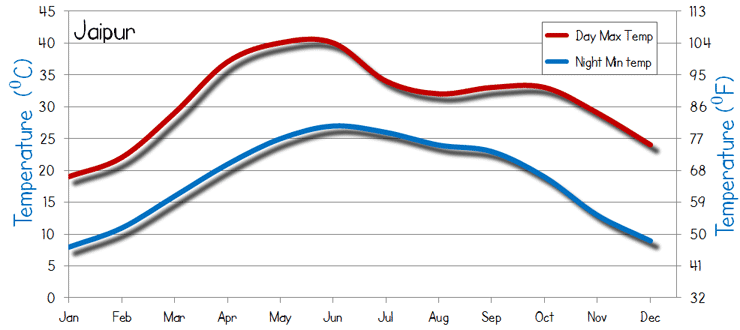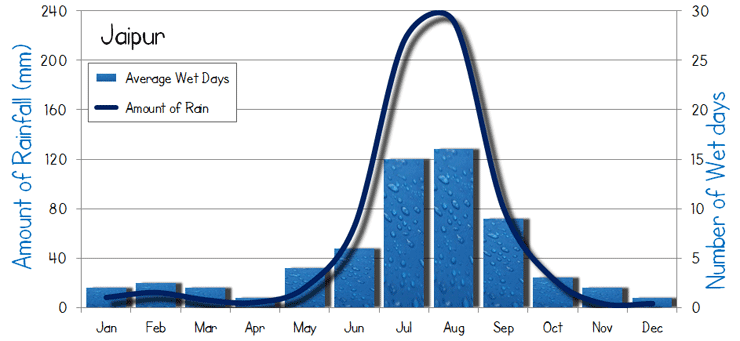When to Visit Jaipur?
Jaipur is situated in an arid, semi-desert region, which has three distinct seasons. Only one season is suitable for visitors, therefore pre-planning is essential before travelling to India and Jaipur. The three seasons of Jaipur are; a warm dry winter, an unbearably hot spring/summer and a brief but intense monsoon season. Unsurprisingly the best season to visit Jaipur is during the winter months, from early November through to February and this is the height of the tourist season.
When to visit Jaipur – Weather
The weather is the most crucial factor when deciding to visit Jaipur. Do not consider visiting Jaipur during the long hot summer (March until July) when the daytime maximum temperatures can reach in excess of 45°C. This intense heat combined with the dust and pollution makes Jaipur unbearable and this is the worst season to visit the whole of India. If you do plan to visit Jaipur in the summer always book air-conditioning in hotels is essential and drink plenty of water.

The average temperature of Jaipur
The winter months (November through to February) is the best time of the year to visit Jaipur and the weather is dry, warm and sunny. As this is considered the height of the tourist season hotel’s charge maximum prices and some of the more popular hotels are sold out. In the middle of winter Jaipur has cool evenings, with temperatures dropping to around 5°C and it often surprises visitors that they may need a warm jumper.
Jaipur Monsoon
The autumn monsoon is formed when intense sun of the summer heats the arid Thar Desert causing a massive area of low pressure. The region of low pressure above the Thar Dessert draws air from the Arabian Sea and this air has high levels of moisture due to evaporation from the sea. As the moist air cools above the land, dense clouds are created and bring in the monsoon rains. The change in wind direction indicates the start of the monsoon season (July) for Jaipur and northern India.

The amount of wet days and rainfall for Jaipur
Unlike many other Indian regions, the monsoon rains of Jaipur fall late in the day and this allows visitors to explore the city during the early part of the day. Rajasthan is possibly the best region of India to visit during the monsoon season but the whole of India is miserably wet and the country is best avoided.
When are Jaipur Festivals?
The two most significant festivals for Jaipur are the Elephant Festival and the Makar Sankranti (the Kite Festival). The elephant festival is a celebration of the great animals and the elephants are beautifully painted and paraded through the streets. Other biazar activities include Elephant polo and Elephant dancing. This single day event is held on the day before the holy day of Holi in March.
Jaipur’s other unique festival is the kite festival, when hundreds of kites are flown above the city. The kites have glass shards on the string lines and each kite battles with neighbors for dominance of the air. This typically confused Indian festival is held on the 14th of January and is the first day that the sun is in the northern hemisphere.
The most entertaining of the Hindu religious festival is Diwali, the celebration of lights. The festival celebrates the victory of light over darkness and is commemorated by fireworks, lanterns and street festivities.
Jaipur India Holiday Travel Guide

















